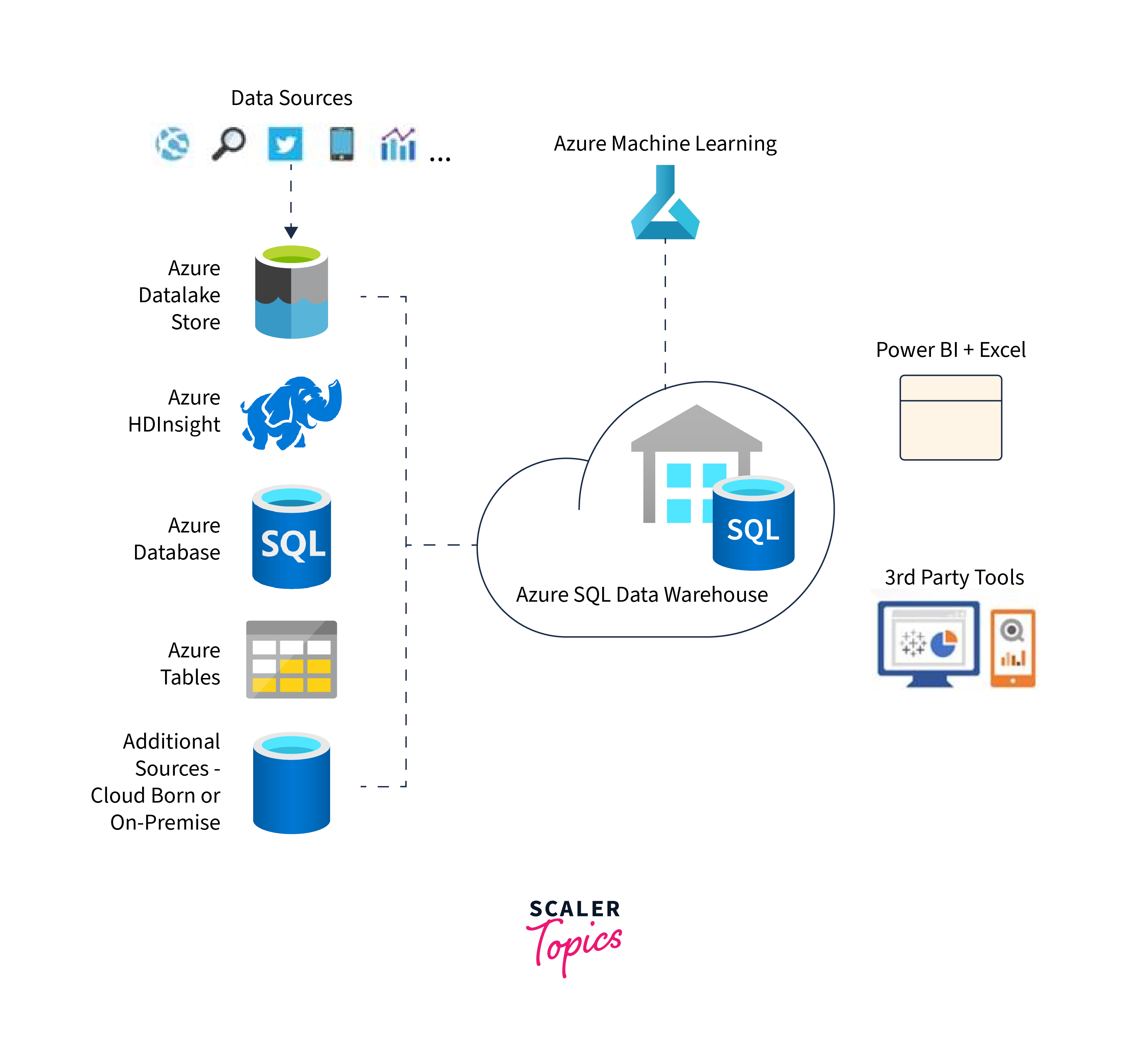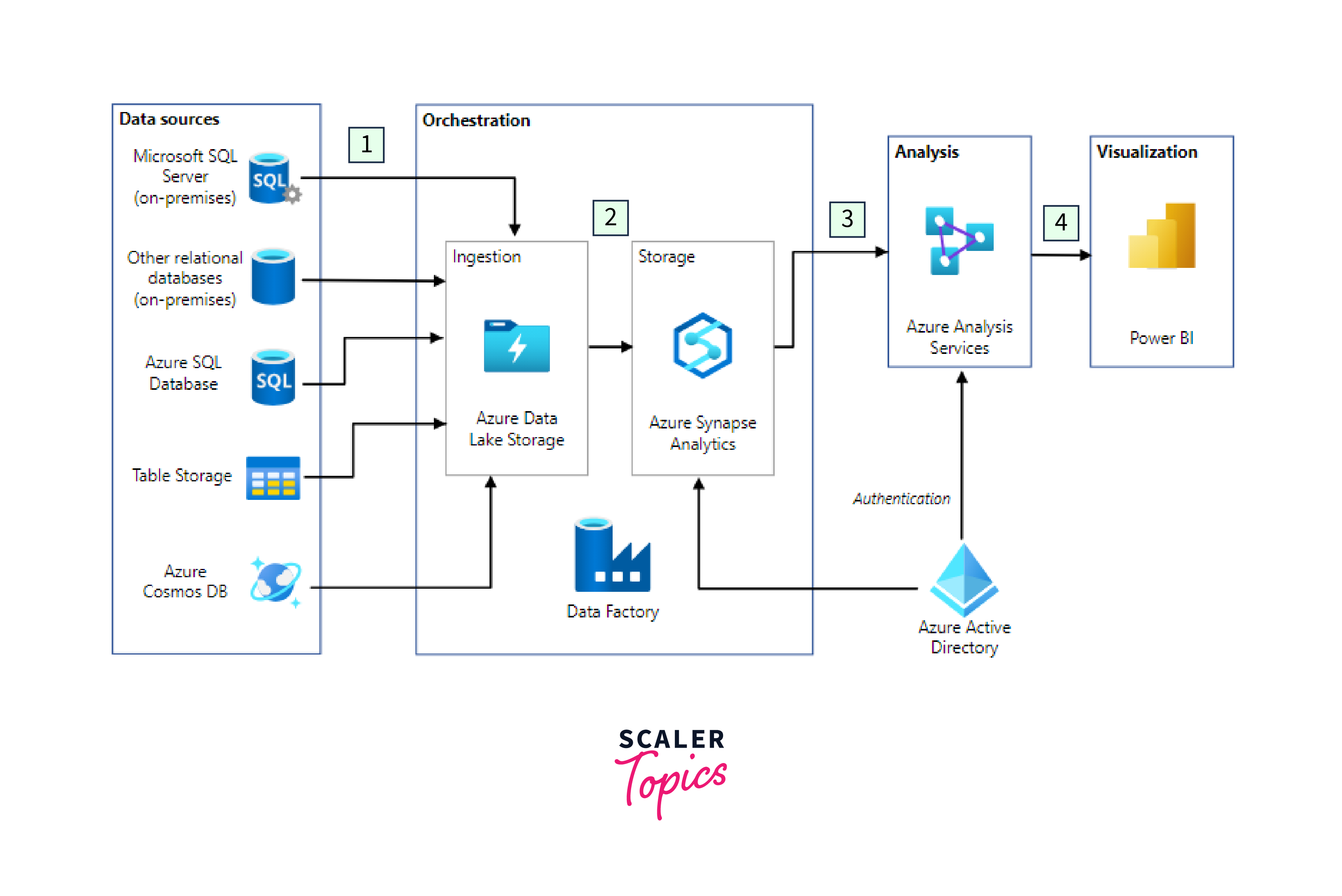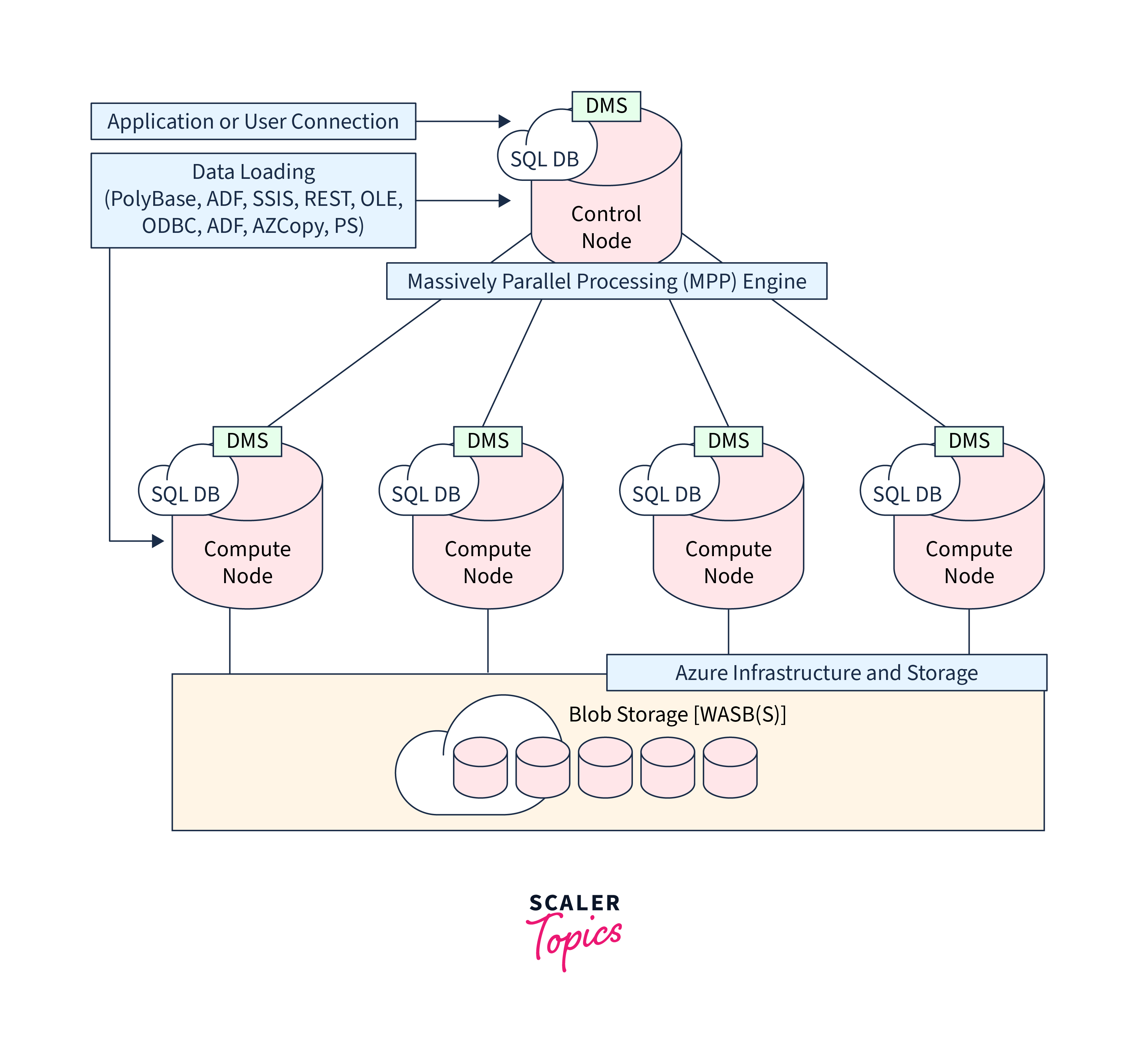SQL Data Warehouse Azure
Azure SQL Data Warehouse, part of Microsoft Azure's cloud services, is a fully managed and scalable data warehouse solution. It allows organizations to process and analyze large volumes of data using massively parallel processing architecture. With on-demand scalability, users can scale resources up or down based on workload requirements. Azure SQL Data Warehouse supports T-SQL queries, integrates with popular analytics tools, and offers features like data encryption and advanced analytics.
Understanding SQL Data Warehouse on Azure
Azure SQL Data Warehouse is a cloud-based data warehousing solution by Microsoft Azure, offering a scalable and fully managed platform for processing and analyzing large volumes of data. Key aspects include:
-
Scalability: Azure SQL Data Warehouse employs a massively parallel processing architecture, enabling organizations to scale compute and storage resources based on their specific workload requirements. This on-demand scalability ensures optimal performance for analytical queries.
-
T-SQL Compatibility: Built on the foundation of Transact-SQL (T-SQL), SQL Data Warehouse supports familiar SQL syntax. This compatibility makes it easier for users already familiar with SQL to transition to and leverage the capabilities of the platform seamlessly.
-
Integration with Analytics Tools: SQL Data Warehouse integrates with popular analytics and business intelligence tools, allowing users to derive insights from their data using tools like Power BI, Azure Machine Learning, and more.
-
Security Measures: The platform offers strong security features, encompassing encryption for data in transit and at rest, role-based access control, and audit functionalities.
-
Advanced Analytics: Organizations can perform advanced analytics within SQL Data Warehouse, leveraging features such as in-database machine learning and the ability to run R and Python scripts directly on the data.
-
Flexible Data Storage: SQL Data Warehouse supports a variety of data storage options, including columnar storage and the ability to store and analyze both structured and unstructured data.

Key Features and Benefits
-
Scalability: Azure SQL Data Warehouse provides on-demand scalability, allowing organizations to dynamically scale compute and storage resources based on the workload.
-
T-SQL Compatibility: Built on Transact-SQL (T-SQL), SQL Data Warehouse supports familiar SQL syntax, making it accessible for users with SQL expertise.
-
Integration with Analytics Tools: The platform seamlessly integrates with popular analytics and business intelligence tools, such as Power BI and Azure Machine Learning, facilitating the generation of valuable insights from data.
-
Security Features: Robust security measures, including data encryption in transit and at rest, role-based access control, and auditing capabilities, ensure the confidentiality and integrity of sensitive data.
-
Advanced Analytics Capabilities: Azure SQL Data Warehouse supports advanced analytics within the database, enabling users to perform in-database machine learning and run R and Python scripts directly on the data for more sophisticated analyses.
-
Flexible Data Storage: The platform accommodates various data storage needs, supporting both structured and unstructured data. It leverages columnar storage for optimized analytics and offers flexibility in handling diverse data types.

Setting Up Azure SQL Data Warehouse
Setting up Azure SQL Data Warehouse involves several steps to configure and deploy the data warehouse environment. Here's an overview of the process:
-
Azure Portal:
- Access the Azure Portal https://portal.azure.com/ and log in to your Azure account.
-
Create a SQL Data Warehouse:
- In the Azure Portal, navigate to the "Create a resource" section.
- Search for "SQL Data Warehouse" and select the appropriate option from the Azure services.
-
Configure Basic Settings:
- Provide essential details such as subscription, resource group, data warehouse name, server details, and performance level (DWU - Data Warehouse Units).
-
Advanced Settings:
- Configure advanced settings, including collation, auditing, and advanced data security options based on your specific requirements.
-
Review and Create:
- Review the configuration settings to ensure accuracy.
- Click "Create" to initiate the deployment process.
-
Deployment Progress:
- Monitor the deployment progress in the Azure Portal. The data warehouse may take a few minutes to provision.
-
Database Objects and Data Loading:
- Create tables, views, and other database objects as needed.
- Load data into the data warehouse using tools or scripts.
-
Query and Analyze:
- Start querying and analyzing data using T-SQL queries within the Azure SQL Data Warehouse environment.
-
Monitoring and Optimization:
- Use Azure Portal tools to monitor query performance, and resource utilization, and optimize the data warehouse for better efficiency.
-
Backup and Security:
- Configure regular backups and implement security measures such as encryption and access controls to safeguard data.
Data Loading and Transformation
To load and transform data in Azure SQL Data Warehouse (now known as Azure Synapse Analytics), you typically use a combination of tools and techniques. Here are the general steps involved:
-
Data Loading:
-
Azure Data Factory: Azure Data Factory is a cloud-based data integration service that allows you to create, schedule, and manage data pipelines that can move data between supported data stores. You can use it to load data into your Azure SQL Data Warehouse.
-
Azure SQL Data Warehouse Copy Wizard: The Azure portal provides a Copy Data tool that can help you copy data to and from the Azure SQL Data Warehouse. This tool is useful for simple scenarios but may not be suitable for complex data transformation requirements.
-
PolyBase: PolyBase is a feature in Azure SQL Data Warehouse that enables you to run queries that read data from external data sources. You can use PolyBase to load data from various sources into your data warehouse.
-
BULK INSERT: You can use the T-SQL BULK INSERT statement to import data from flat files into Azure SQL Data Warehouse tables. This method is suitable for loading large amounts of data from text files or CSV files.
-
-
Data Transformation:
-
T-SQL Queries: Use T-SQL queries to transform data within Azure SQL Data Warehouse. You can perform various data manipulation tasks, such as filtering, aggregating, and joining tables using T-SQL.
-
Stored Procedures: Create stored procedures to encapsulate and reuse complex data transformation logic. This can help improve code organization and maintainability.
-
Views: Views can be used to encapsulate complex queries and transformations. They provide a way to abstract the underlying data model and simplify querying.
-
Data Movement with PolyBase: PolyBase can also be used for data movement between different SQL Data Warehouses or external data sources. You can use PolyBase external tables to reference external data and perform transformations.
-
-
Data Partitioning and Indexing: Design your tables with an appropriate distribution and indexing strategy to optimize query performance. This may involve using hash-distributed tables, round-robin tables, or applying appropriate indexes.
-
Monitoring and Optimization: Regularly monitor the performance of your data warehouse queries and take steps to optimize as needed. This may involve reorganizing indexes, updating statistics, or making schema changes.
Remember to consider the scale and performance aspects of your Azure SQL Data Warehouse when designing your data loading and transformation processes. Additionally, it's essential to choose the most suitable method based on your specific requirements and constraints.

Querying and Managing Data
Querying and managing data in Azure SQL Data Warehouse involves using T-SQL queries and various management techniques to extract valuable insights. Here's an overview of key aspects:
-
T-SQL Queries:
- Utilize Transact-SQL (T-SQL) to write queries for retrieving, aggregating, and analyzing data within Azure SQL Data Warehouse. Leverage familiar SQL syntax for seamless querying.
-
Performance Optimization:
- Optimize query performance by designing efficient queries, creating appropriate indexes, and utilizing distribution and partitioning strategies.
-
Distribution and Partitioning:
- Leverage distribution and partitioning techniques to distribute data across nodes for parallel processing. Choose distribution and partitioning strategies based on query patterns and workload requirements.
-
Statistics and Indexing:
- Maintain up-to-date statistics on tables to assist the query optimizer in generating efficient execution plans. Create indexes strategically to improve query performance, considering both clustered and non-clustered index options.
-
Data Compression:
- Implement data compression to reduce storage requirements and improve query performance. Azure SQL Data Warehouse supports various compression options to optimize data storage.
Integration with Azure Ecosystem
Azure SQL Data Warehouse seamlessly integrates with various services within the Azure ecosystem, enhancing its capabilities and providing a comprehensive environment for data analytics and management. Here's an overview of key integrations:
-
Azure Data Factory:
- Utilize Azure Data Factory for orchestrating and automating ETL (Extract, Transform, Load) workflows. This integration facilitates efficient data movement from various sources into Azure SQL Data Warehouse.
-
Azure Databricks:
- Combine Azure SQL Data Warehouse with Azure Databricks for advanced analytics and machine learning. Process and analyze large datasets using Databricks and store results in SQL Data Warehouse for reporting.
-
Azure Synapse Analytics (formerly SQL Data Warehouse):
- Azure Synapse Analytics integrates seamlessly with Azure SQL Data Warehouse, allowing for the analysis of large volumes of data using on-demand and provisioned resources.
-
Power BI:
- Connect Azure SQL Data Warehouse to Power BI for powerful and interactive data visualization. Power BI integrates effortlessly with SQL Data Warehouse, enabling users to create insightful dashboards and reports.
-
Azure Stream Analytics:
- Combine Azure SQL Data Warehouse with Azure Stream Analytics for real-time data processing. Ingest and analyze streaming data, and store the results in SQL Data Warehouse for historical analysis.

Scaling and Performance Optimization
Achieving optimal performance in Azure SQL Data Warehouse involves strategic scaling and performance optimization techniques. Here's a comprehensive guide:
-
Data Distribution and Partitioning:
- Choose appropriate distribution and partitioning strategies for tables based on query patterns. Optimize data distribution to evenly distribute data across nodes for parallel processing.
-
Provisioned Resources (DWUs):
- Adjust Data Warehouse Units (DWUs) to allocate computing resources according to workload requirements. Scale up for increased performance during peak times and scale down during periods of lower demand.
-
Indexing Strategies:
- Design and implement indexes judiciously to enhance query performance. Utilize clustered and non-clustered indexes based on query patterns, considering the impact on insert/update operations.
-
Statistics Maintenance:
- Keep statistics up-to-date to assist the query optimizer in generating efficient execution plans. Regularly update statistics on tables to reflect changes in data distribution.
-
Query Optimization:
- Analyze query execution plans using tools like Azure SQL Data Warehouse Query Performance Insight. Identify and optimize resource-intensive queries to improve overall system performance.
-
Materialized Views:
- Use materialized views to precompute and store aggregated results for frequently used queries. This reduces the computational load during query execution.
-
Data Compression:
- Implement data compression to reduce storage requirements and enhance query performance. Choose compression options based on the data characteristics.
Cost Management and Monitoring
-
DWUs Adjustment:
- Dynamically adjust Data Warehouse Units (DWUs) based on workload to optimize costs.
-
Query and Resource Monitoring:
- Monitor query and resource utilization for performance insights and cost optimization.
-
Azure Advisor and Alerts:
- Utilize Azure Advisor recommendations and set up alerts for proactive cost management.
-
Storage Optimization:
- Optimize storage with compression, archiving, and efficient data retention policies.
-
Pause and Resume:
- Leverage pause and resume capabilities during idle periods to reduce costs.
-
Concurrency Control:
- Implement efficient concurrency control for optimal resource utilization.
-
Cost Estimation and Planning:
- Use Azure Pricing Calculator and tools for cost estimation and budget planning.
-
Tagging and Categorization:
- Tag resources for tracking costs by department, project, or purpose.
Conclusion
- Azure SQL Data Warehouse offers scalable performance with adjustable Data Warehouse Units (DWUs) to meet varying workload demands.
- Leveraging Transact-SQL (T-SQL), users benefit from a familiar SQL syntax for seamless querying and data manipulation.
- Seamless integration with Azure services like Data Factory, Databricks, and Power BI enhances analytics and data processing capabilities.
- Robust security features, including Azure Active Directory integration and encryption, ensure data confidentiality and compliance.
- Dynamic scaling allows organizations to adjust resources, optimizing costs based on actual usage patterns.
- Utilize Azure Advisor and monitoring tools for query performance insights, recommendations, and efficient resource utilization.
